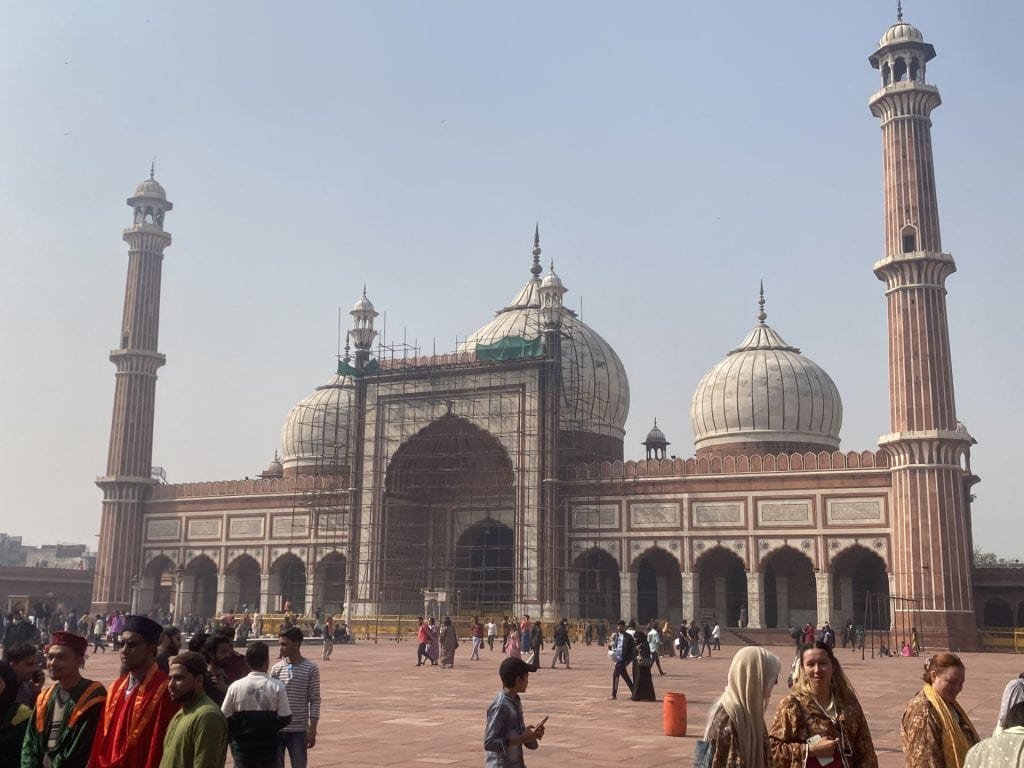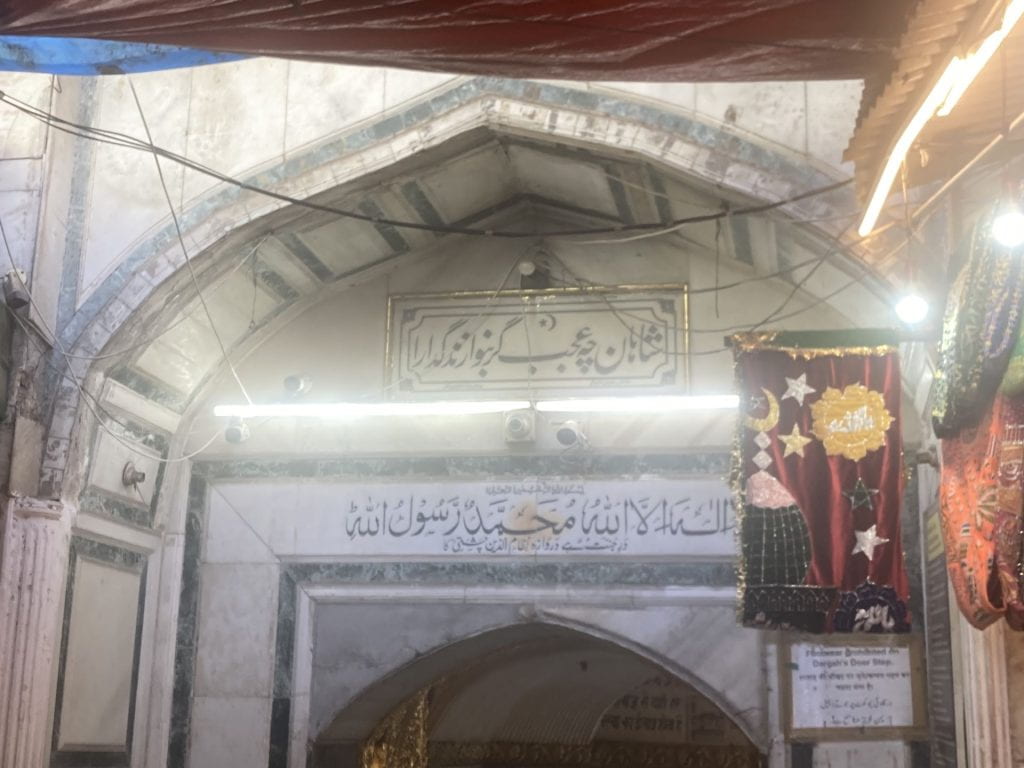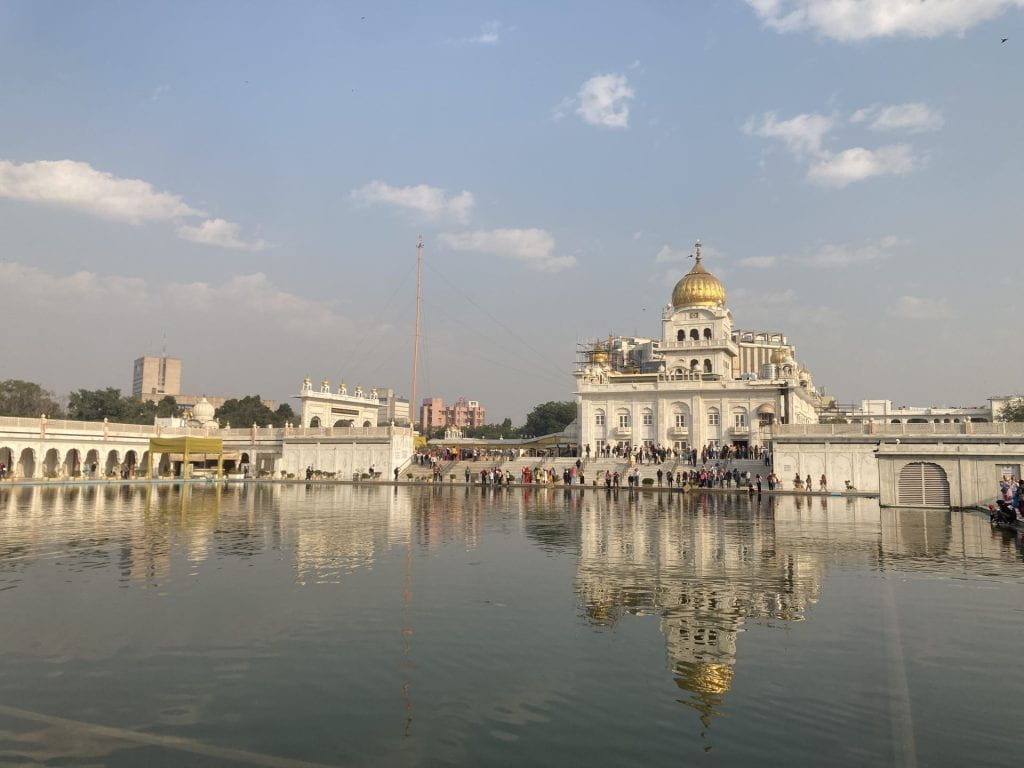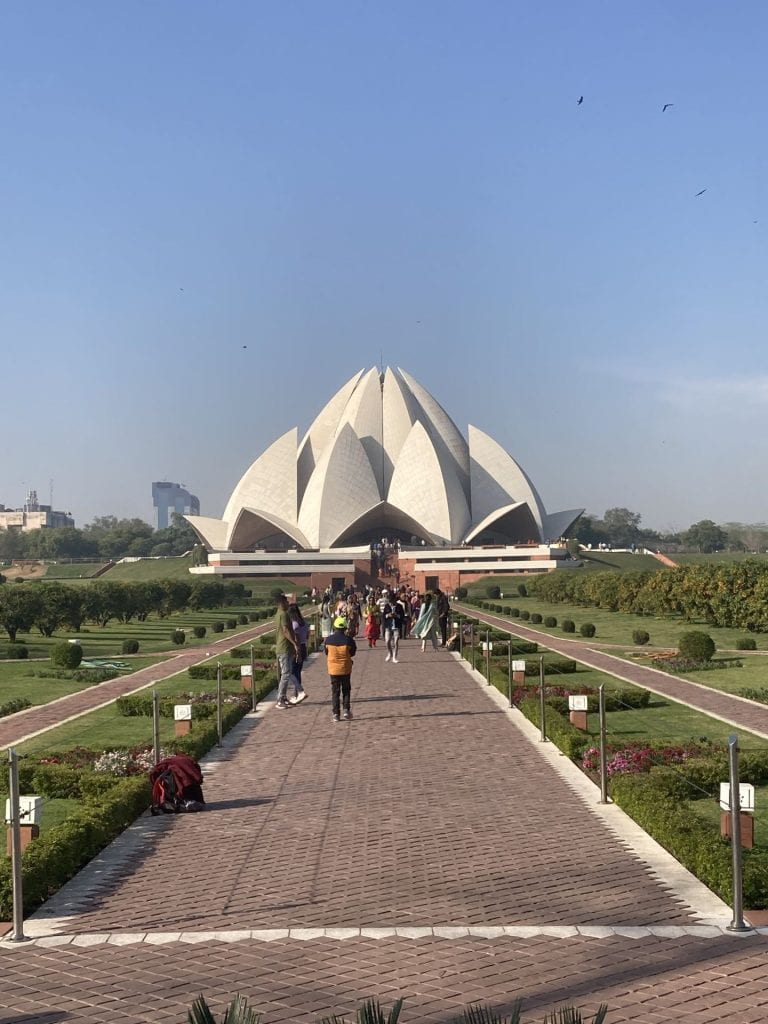While we stayed in Delhi, we visited a number of different places of worship and religious significance to a number of the different religions communities of India. Given that in New Zealand, religion is not something that is often talked about, nor an aspect of day to day life that one would often see publicly, it was interesting to see the variety of different religions that people follow in India, and to learn about the different histories and principles that underpinned each of them.
Jama Masjid
When we visited Old Delhi or Shahjahanabad, the city built by Mughal Emperor Shah Jahan in Delhi, we visited the Jama Masjid, or Friday Mosque. The Mughals were a Muslim dynasty, with roots in the also Muslim Timurid Dynasty of Central Asia. The Mosque had a very grand design with a wide courtyard and pool of water for performing wudu, the act of cleaning oneself before entering a mosque to pray. We met a man here who was cleaning himself before praying, and he very welcomingly showed Brandon and I how to correctly perform it ourselves. We also went to a small shrine near the back wall where an imam showed us some of the relics that they kept at the mosque. They had the shoes and the foot imprints, and a hair of the beard of Prophet Muhammad. He also showed us a 1400 year old Quran written by the Prophet’s Son in Law. The Quran was taken from the Ottoman empire by Amir Timur when he invaded, then the Quran was finally taken to India by Babur, the last of the Central Asian Timurid dynasty, when he invaded India and established the Mughal Empire. For me it was very interesting to see this connection between Indian and Central Asian history.

Nizamuddin Dargah
On the day that we visited New Delhi, we also visited Nizamuddin Dargah, which showed us another side of Islam to that which we saw at the Jama Masjid. This was a Sufi shrine, Sufism is a mystical branch of Islam that involves many different esoteric practices to other types of Sunni (and Shia) Islam. This shrine was built around the grave of Muhammad Nizamddin Auliya, a saint who commissioned the construction of a baoli (communal well) behind the grave. It was built during the reign of Ghiyasuddin Tughlaq (during the Delhi Sultanate) who wanted workers to focus on building his fort in Tughlaqabad instead of the baoli. Nizamuddin put a curse on the construction of this fort to be a place where there is no water and only animals would graze there. Very quickly this turned out to be true and the fort was abandoned soon after. There was a man singing devotional songs to Nizamuddin outside of his tomb. Inside the tomb the grave was covered with many different cloths and in flower petals as offerings, which showed a very different type of worship to that which we saw at the Jama Masjid.

Sri Digambar Jain Lal Mandir
Also during our visit to Old Delhi, we also visited the Sri Digambar Jain Lal Mandir of the Digambara or “Sky Clad” tradition of Jainism, meaning that the monks who practise this tradition do not wear clothes, and thus are ‘clad by the sky.’ There were strict rules about ensuring that we do not enter with any products of dead animals such as meat or leather, due to Jainism’s strict adherence to Ahimsa, or ‘non-violence’ which means that one should not harm other forms of life. This principle of Ahimsa was incorporated by Mahatma Gandhi into his philosophies of non-violent resistance. Gandhi was strongly influenced by the philosophies of Jainism generally as he grew up very close to the Jain community in Gujarat. The temple was elaborately decorated and had many pictures of Mahavira, the founder of Jainism on the walls, and others performing acts of compassion. Attached to the temple was a hospital for birds. Birds of many different types from all over Delhi are brought here for treatment. Seeing this part of the temple was very moving to see the amount of compassion that the adherants showed towards these birds as I don’t think that these birds would be cared for the same way if they were in New Zealand.

Our local Hindu Mandir
Later on we took a trip to our local Hindu Mandir around the corner from our hotel. The temple had many different shrines to various gods. There were shrines to Shiva, Ganesha, Rama and Sita, Hanuman and many others. The priests gave us bindis on our foreheads and kautuka (red thread worn around the wrist as a protection) before we sat before the Rama, Sita and Hanuman shrine while they chanted mantras. Nick talked to us about various aspects of Hindu worship, such as that it is kathenotheism, in that there are many gods, but one god is worshipped at a given time. He also told us about the myths of some of the Gods, such as in the Ramayana, a Hindu Epic about Rama and his consort Sita, how Lord Hanuman (the monkey god who helps Rama) was tasked with finding a special herb in the Himalayas for Sita, but he forgot how to identify the plant so he took the whole mountain back with him.

Sri Bangla Sahib Gurudwara
We also visited the Sri Bangla Sahib Gurudwara, a place of worship for people of the Sikh religion. The temple had beautiful architecture, with golden domes and a large water tank that people would walk around. We learned about the symbol of Sikhism and how it is composed of various weapons which is related to its history of its foundation in the Punjab, a region of India frequently under attack. We also learned about Sikhism’s conception of God, that is one God that is present within all of creation. We briefly went to the kitchens of the langar hall on the Gurudwara to see where volunteers prepare massive amounts of free vegetarian food each day that is offered to people of all religious backgrounds as long as they all eat together on the floor in the langar hall. This practice of giving free food to all is based on the Sikh ideas of engaging in Seva (selfless service) and also that no one religion has the absolute truth.

Lotus Temple Baha’i faith
The final place of worship we visited in Delhi was the Lotus Temple, a large lotus shaped structure that reminded many of us of the Matrimandir we visited in Auroville, and also of the Sydney Opera House, which was a place of worship for the Baha’i faith. The Baha’i faith follows the teachings of Baha’u’llah, an Iranian prophet, who Baha’i regard to be a prophet of God in a long line of prophets including Jesus, Muhammad and Buddha. In the service that we attended in the temple, texts of different religions were read out, writings of Baha’u’llah, The Lord’s Prayer of the Christian faith, and sections of the Bhagavad Gita – a holy text of Hinduism. Walking around the visitors centre afterwards we learned about the history and beliefs of the Baha’i faith. The Baha’i faith believes that at different times different prophets come to reveal teachings of one God, and that these teachings change for different times in human history. It also believes in creating a new world order rejecting racism, sexism and working towards unity and prosperity of all people.

